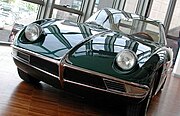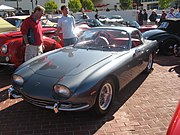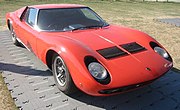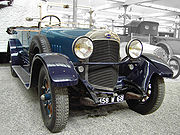
The Miura began as a clandestine racing prototype developed by Lamborghini engineers against F. Lamborghini's wishes In contrast to his rival Enzo Ferrari, Ferruccio Lamborghini had decided early on that there would be no factory-supported racing of Lamborghinis, viewing motorsport as too expensive and too draining on company resources.[citation needed] This was unusual for the time, as many sports car manufacturers sought to demonstrate the speed, reliability, and technical superiority through motorsport participation. Enzo Ferrari in particular was known for considering his road car business merely a source of funding for his participation in motor racing. Ferrucio's policy led to tensions between him and his engineers, many of whom were racing enthusiasts; some had previously worked at Ferrari. The engineers decided to ignore their chief's whims, using their spare time to develop a mid-engined car with racing pedigree. Lamborghini soon learned of the project, and decided to allow the men to continue their project, with the continued insistence that no racing models would be allowed. Ironically, when the engineers' pet project was released as a production model a few years later, it would become the car that would propel the automaker to widespread fame and set the benchmark for future high-powered sports cars; that car was the Miura.
The closest the company came to building a true race car under Lamborghini's supervision were a few highly modified prototypes, including those built by factory test driver Bob Wallace, such as the Miura SV-based "Jota" and the Jarama S-based "Bob Wallace Special". Under the management of Georges-Henri Rossetti, Lamborghini entered into an agreement with BMW to build a production racing car in sufficient quantity for homologation. However, Lamborghini was unable to fulfill its part of the agreement. The car was eventually developed in-house by the BMW Motorsport Division, and was manufactured and sold as the BMW M1.[10][11]

The 1991 Lotus 102B, which featured a Judd V8 in place of the unreliable Lamborghini V12 used in the 101 and 102 In the 1980s, Lamborghini developed the QVX for the 1986 Group C championship season. One car was built, but lack of sponsorship caused it to miss the season. The QVX competed in only one race, the non-championship 1986 Southern Suns 500 km race at Kyalami in South Africa, driven by Tiff Needell. Despite the car finishing better than it started, sponsorship could once again not be found and the program was cancelled.[12]
Lamborghini was an engine supplier in Formula One between the 1989 and 1993 Formula One seasons. It supplied engines to Larrousse (1989-1990,1992-1993), Lotus (1990), Ligier (1991), Minardi (1992), and to the Modena team in 1991. While the latter is commonly referred to as a factory team, the company saw themselves as a supplier, not a backer. The 1992 Larrousse–Lamborghini was largely uncompetitive but noteworthy in its tendency to spew oil from its exhaust system. Cars following closely behind the Larrousse were commonly colored yellowish-brown by the end of the race.[citation needed]
In late 1991, a Lamborghini Formula One motor was used in the Konrad KM-011 Group C sports car, but the car only lasted a few races before the project was canceled. The same engine, re-badged a Chrysler by Lamborghini's then parent company, was tested by McLaren towards the end of the 1993 season, with the intent of using it during the 1994 season. Although driver Ayrton Senna was reportedly impressed with the engine's performance, McLaren pulled out of negotiations, choosing a Peugeot engine instead, and Chrysler ended the project.

A Murcielago R-GT participating in the FIA GT Championship at Silverstone in 2006
Two racing versions of the Diablo were built for the Diablo Supertrophy, a single-model racing series held annually from 1996 to 1999. In the first year, the model used in the series was the Diablo SVR, while the Diablo 6.0 GTR was used for the remaining three years.[13][14]
Lamborghini developed the Murciélago R-GT as a production racing car to compete in the FIA GT Championship, the Super GT Championship and the American Le Mans Series in 2004. The car's highest placing in any race that year was the opening round of the FIA GT Championship at Valencia, where the car entered by Reiter Engineering finished third from a fifth-place start.[15][16] In 2006, during the opening round of the Super GT championship at Suzuka, a car run by the Japan Lamborghini Owners Club garnered the first victory (in class) by an R-GT.
A GT3 version of the Gallardo has been developed by Reiter Engineering.[17]
A Murciélago R-GT entered by All-Inkl.com racing, driven by Christophe Bouchut and Stefan Mücke, won the opening round of the FIA GT Championship held at Zhuhai International Circuit, achieving the first major international race victory for Lamborghini.[18]
































